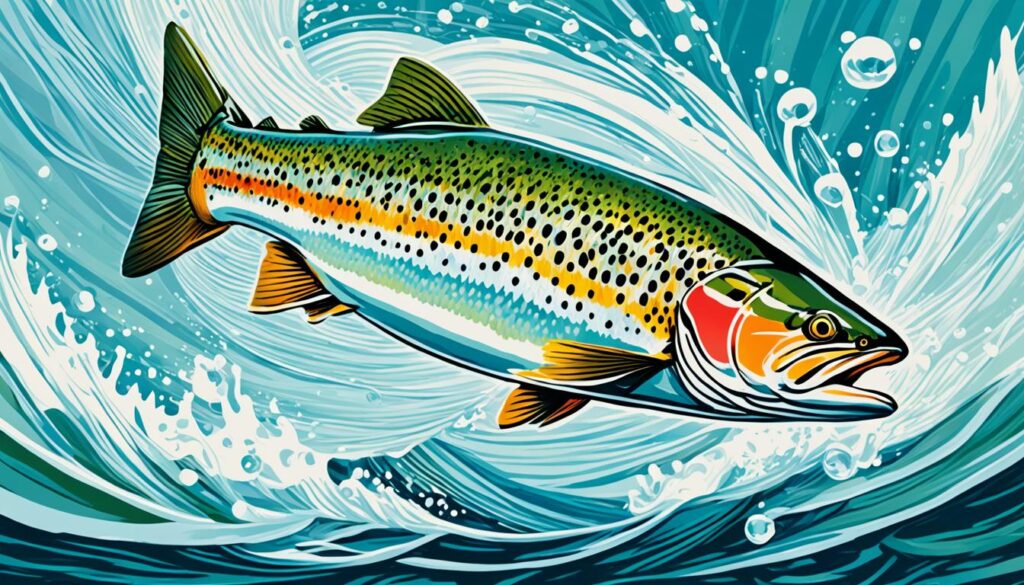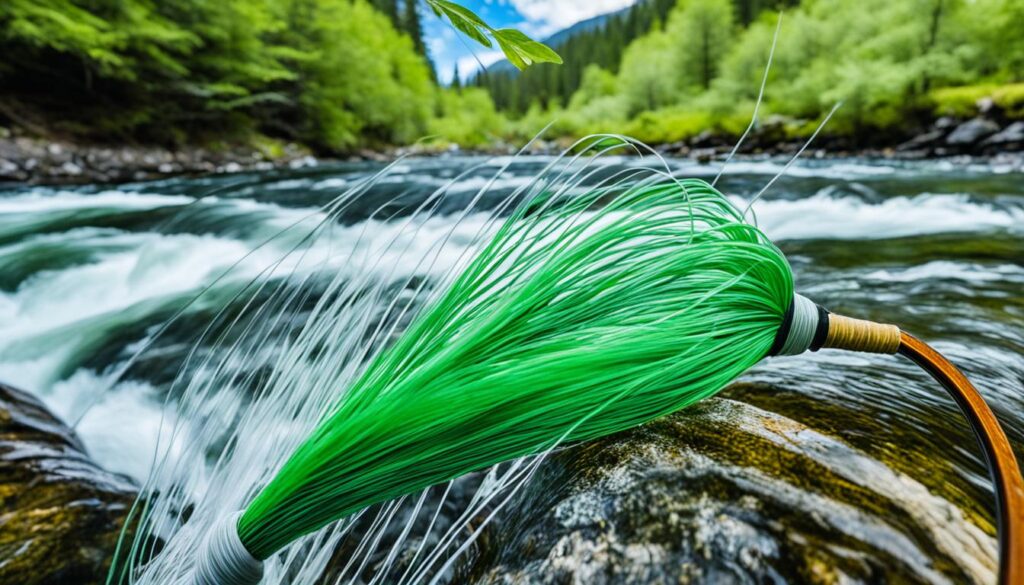This post contains affiliate links.
Are you ready to reel in the biggest trout of your life? It all starts with choosing the right fishing line. But with so many options out there, how do you know which one is the best for trout fishing? Well, get ready to cast your doubts aside, because in this ultimate trout fishing line guide, we’ll reveal the top-rated lines, uncover expert recommendations, and provide you with everything you need to know to make the right choice for your next angling adventure. So put on your waders and let’s dive in!
- Discover the top-rated trout fishing lines
- Learn expert tips to enhance your angling success
- Understand the strengths and weaknesses of different line types
- Find the best line for various water conditions
- Match the line test to different trout species
The Different Types of Fishing Line for Trout
When targeting trout, it’s crucial to choose the right fishing line. There are several types to consider, each with its own strengths and weaknesses. Let’s dive into the different options:
1. Monofilament Fishing Line
Monofilament fishing line is a popular choice among trout anglers. It offers versatility, affordability, and ease of use. With its single-strand construction, monofilament line provides good knot strength and is less prone to tangles. However, it does have a higher visibility in the water compared to other types like fluorocarbon. Nonetheless, monofilament line is suitable for various trout fishing methods, including casting and trolling.
2. Fluorocarbon Fishing Line
Fluorocarbon fishing line is known for its excellent invisibility in the water. This makes it ideal for targeting skittish trout in clear waters. With its low stretch and high abrasion resistance, fluorocarbon line offers superior sensitivity and strength. However, it is typically more expensive than monofilament line and can be more challenging to handle, especially for beginners. It’s best to use fluorocarbon line when you need the added stealth and sensitivity.
3. Braided Fishing Line
Braided fishing line is less commonly used for trout fishing but can be effective in certain situations. It consists of multiple strands woven together, resulting in a strong and durable line. Braided line has zero stretch and high sensitivity, allowing for better feel and increased hook-setting power. However, it is more visible in clear water and can be prone to fraying unless paired with a fluorocarbon or monofilament leader. Braided line is often preferred for trolling for trout due to its thin diameter and high strength.
4. Fly Fishing Line
Fly fishing for trout requires specialized fly lines. These lines are specifically designed to cast lightweight flies accurately. Fly lines come in various weights, with weight forward lines being popular among beginners for their ease of use. The weight of the fly line should be chosen based on the fishing conditions and target trout species. Heavier lines are suitable for fishing in tight areas, while lighter lines allow for longer casts and less disturbance on the water’s surface.
“The type of fishing line you choose can greatly impact your trout fishing experience. Each type has its advantages and disadvantages, so it’s essential to consider your fishing style and the conditions you’ll be fishing in.”
Now that you have a better understanding of the different types of fishing line available for trout, you can make an informed decision based on your preferences and fishing needs. The following table provides a summary of the key characteristics of each type:
| Fishing Line Type | Key Characteristics |
|---|---|
| Monofilament Fishing Line | Affordable, versatile, good knot strength, increased visibility |
| Fluorocarbon Fishing Line | Invisible underwater, low stretch, high abrasion resistance |
| Braided Fishing Line | Zero stretch, high sensitivity, thin diameter, visible in clear water |
| Fly Fishing Line | Specialized for fly casting, various weights available |
Remember, choosing the right fishing line is just one part of the equation for success. Factors such as water conditions, trout behavior, and fishing techniques also play crucial roles in your fishing outcomes. Take these into account and experiment with different lines to find what works best for you.
Monofilament Fishing Line for Trout
When it comes to trout fishing, monofilament fishing line is a popular choice among anglers. Its versatility, affordability, and compatibility with various trout fishing methods make it a go-to option for many enthusiasts. Whether you’re trolling, casting, or bait fishing, monofilament line has got you covered.
Available in a wide range of colors and sizes, monofilament line allows you to customize your setup based on your preferences and fishing conditions. Whether you’re targeting rainbow trout, brown trout, or brook trout, there’s a monofilament line suitable for your needs.
However, as with any fishing line, monofilament has its pros and cons. One of the primary advantages of monofilament line is its affordability compared to other types of fishing line. It provides excellent value for money without compromising performance.
On the downside, monofilament line can be prone to coiling, which can affect your casting distance and accuracy. Additionally, it has relatively low abrasion resistance, making it susceptible to wear and tear when fishing in rocky or abrasive environments.
“Monofilament fishing line offers versatility and affordability for trout fishing. Although it may have some drawbacks, it remains a reliable choice for anglers looking to have a successful day on the water.”
To overcome these limitations, it is recommended to invest in a premium monofilament line. These lines often have enhanced features such as reduced memory for reduced coiling, improved knot strength, and higher abrasion resistance. These qualities can significantly improve your fishing experience and increase your chances of landing that trophy trout.
Pros and Cons of Monofilament Fishing Line for Trout
Here’s a breakdown of the pros and cons of using monofilament fishing line for trout:
- Pros:
- Affordable and readily available
- Works well with various trout fishing methods
- Customizable options in terms of color and size
- Cons:
- Prone to coiling and memory
- Low abrasion resistance
Recommended Monofilament Line for Trout Fishing
To help you make an informed decision, here are some highly recommended monofilament fishing lines for trout:
| Brand | Model | Strength (lb) |
|---|---|---|
| Berkley | Trilene XL | 4 – 20 |
| P-Line | CXX X-Tra Strong | 4 – 20 |
| Stren | Original Monofilament | 6 – 20 |
| Seaguar | Blue Label | 4 – 20 |
These monofilament lines offer excellent performance, durability, and reliable knot strength, ensuring a successful trout fishing experience.
Remember, choosing the right fishing line is crucial for maximizing your chances of a successful catch. Consider the fishing conditions, trout species, and your personal preferences when selecting the best monofilament line for your trout fishing adventures.
Fluorocarbon Fishing Line for Trout
When it comes to trout fishing in clear water, using fluorocarbon fishing line can give you a distinct advantage. This type of fishing line is renowned for its invisibility in the water, making it the best fluorocarbon line for trout. With its low stretch and high abrasion resistance, fluorocarbon line allows for more sensitivity and better hook sets, increasing your chances of landing a trophy trout.
One of the key advantages of fluorocarbon line is its ability to sink faster than other lines. This makes it an ideal choice for presenting baits and lures to trout that are wary and often found near the bottom. Its ability to blend in with the natural surroundings while sinking quickly can help fool even the most cautious trout.
While fluorocarbon line offers numerous benefits, there are a few considerations to keep in mind. Firstly, it can be more expensive than other fishing line options. Although the initial investment may be higher, the increased performance and durability of fluorocarbon line can justify the cost in the long run.
Additionally, fluorocarbon line may not be as easy to handle for beginners compared to other types of fishing line. Its stiffness can make it more prone to backlash, especially if not properly spooled on the reel. However, with practice and proper technique, anglers of all experience levels can benefit from using fluorocarbon line for trout fishing.
“Fluorocarbon fishing line is like your secret weapon for trout fishing in clear water. Its invisibility and fast sinking properties give you an edge when targeting those finicky trout.”

Advantages of Fluorocarbon Fishing Line for Trout
- Excellent invisibility in clear water
- Low stretch for superior sensitivity and improved hook sets
- High abrasion resistance for added durability
- Faster sinking properties for effective bait and lure presentation
Disadvantages of Fluorocarbon Fishing Line for Trout
- Higher cost compared to other fishing line options
- Stiffness may pose a challenge for beginners
| Advantages of Fluorocarbon Fishing Line for Trout | Disadvantages of Fluorocarbon Fishing Line for Trout |
|---|---|
| Excellent invisibility in clear water | Higher cost compared to other fishing line options |
| Low stretch for superior sensitivity and improved hook sets | Stiffness may pose a challenge for beginners |
| High abrasion resistance for added durability | |
| Faster sinking properties for effective bait and lure presentation |
Table: Advantages and Disadvantages of Fluorocarbon Fishing Line for Trout”
–>Braided Fishing Line for Trout
While not as popular for trout fishing, braided fishing line can be a game-changer in certain situations. Its unique characteristics offer advantages and disadvantages that anglers should consider before hitting the water.
“Braided line gives you the confidence to land bigger trout and improves your overall fishing experience.”
Advantages of Braided Line
- Braided fishing line has zero stretch, providing enhanced sensitivity and better hooksets. You’ll feel even the slightest nibble, allowing you to react swiftly and reel in your catch.
- With a smaller diameter compared to monofilament or fluorocarbon lines, braided line offers superior strength and allows for longer casts. This increases your chances of reaching those elusive trout lurking in deeper waters.
- Its high visibility can actually be an advantage in low-light conditions, as it enables you to track your line movement and detect strikes more easily.
Disadvantages of Braided Line
- Braided line can be more visible in clear water, potentially spooking wary trout. To mitigate this, it is recommended to use a fluorocarbon or monofilament leader, which will provide the necessary invisibility and reduce the risk of trout detecting your line.
- Due to its construction, braided line can be prone to fraying and bleeding color over time, especially if you’re fishing around rocks or structures. Regularly inspecting and maintaining your line will help prevent unwanted breakoffs.
Using Braided Line for Trolling Trout
One of the best ways to maximize the benefits of braided line for trout fishing is by utilizing it for trolling. The combination of zero stretch, high sensitivity, and long casting distances makes braided line ideal for covering large areas of water and effectively targeting roaming trout.
When trolling with braided line, it is important to use a rod and reel setup specifically designed for this technique. Consider a medium to medium-heavy spinning or baitcasting rod with a high-quality drag system to handle the powerful runs of trophy trout.

Fly Fishing Line for Trout
Fly fishing is a unique art that requires specific equipment, and selecting the right fly line for trout is essential for a successful angling experience. Not all fly lines are created equal, and understanding the different options available will give you an edge on the water.
For beginners, a weight forward line is highly recommended. This type of fly line is designed to make casting easier and provide excellent turnover, allowing you to present your fly accurately. With a weight forward line, you’ll spend less time untangling knots and more time catching trout.
When choosing the right fly line weight for trout, consider the conditions you’ll be fishing in and the target fish species. Heavier lines, such as a 6 or 7 weight, are ideal for fishing in tight areas or when dealing with wind. They offer better control and accuracy, enabling you to place your fly precisely where you want it. On the other hand, lighter lines, like a 3 or 4 weight, are perfect for longer casts and delicate presentations. They create less impact on the water, reducing the chances of spooking wary trout.

Best Fishing Line for Different Water Conditions
When it comes to trout fishing, understanding the impact of water conditions on your fishing line is crucial. The right fishing line can help you adapt to various water conditions and increase your chances of a successful catch. Whether you’re fishing in clear water or stained water, choosing the best fishing line for the environment can make all the difference.
In clear water: When the water is crystal clear, trout can easily spot fishing lines. To enhance your stealth and increase your chances of fooling wary trout, fluorocarbon line is the top recommendation. Fluorocarbon line is virtually invisible underwater, allowing you to present your bait or lure with minimal disturbance. Its excellent sensitivity and abrasion resistance make it a reliable choice for clear water conditions.
In stained water: When fishing in stained or murky water, visibility is reduced, and trout are less likely to see fishing lines. Monofilament or braided lines are excellent choices for these conditions. Monofilament line offers good visibility and has a high resistance to abrasion, making it suitable for stained water fishing. Braided line, on the other hand, provides superior strength, sensitivity, and castability. Using a high-visibility braided line combined with a fluorocarbon or monofilament leader can be a smart strategy for fishing in stained water.
By selecting the best fishing line for different water conditions, you can adapt to the trout’s surroundings and dramatically improve your chances of success. Remember to take into account the water clarity and adjust your fishing line accordingly to maximize your angling experience.
| Water Conditions | Recommended Fishing Line |
|---|---|
| Clear Water | Fluorocarbon line |
| Stained Water | Monofilament or braided line |
What Line Test Is Best for Trout Species?
When it comes to trout fishing, choosing the right line test is crucial for optimizing your success. Different trout species have varying sizes and behaviors, necessitating the use of specific line weights to ensure a productive angling experience. Let’s take a closer look at the recommended line weights for rainbow trout, cutthroat trout, brown trout, brook trout, and lake trout.
Rainbow Trout
Rainbow trout are known for their energetic fights and acrobatic jumps. To conquer these spirited fighters, a line test in the range of 4 to 6 pounds is recommended. This line weight provides the necessary strength to handle the trout’s aggressive behavior and ensures a more secure hookset when battling against their resistance.
Cutthroat Trout
Cutthroat trout inhabit both rivers and lakes and put up a decent fight. For these trout, a line test ranging from 2 to 4 pounds is generally sufficient. This weight allows for improved sensitivity and control when casting to spot-and-stalk or presenting small streamers, making it easier to entice cutthroat trout to strike.
Brown Trout
Brown trout are often regarded as some of the craftiest and most elusive trout species. To overcome their wariness and stealth, it’s recommended to use a line test ranging from 4 to 6 pounds. This line weight provides the necessary strength to handle large brown trout while offering enough finesse to present delicate dry flies or nymphs with precision.
Brook Trout
Brook trout, also known as speckled trout, are typically found in cold, clear streams and mountainous areas. These beautiful fish are known for their stunning colors and willingness to take a well-presented fly. To target brook trout, a line test ranging from 2 to 4 pounds is ideal. This weight offers excellent sensitivity for detecting subtle strikes and provides enough strength to handle these feisty fish in tight quarters.
Lake Trout
Lake trout, the largest of the trout species, require a sturdier line test to handle their size and power. When targeting lake trout, it is recommended to use a line test ranging from 8 to 12 pounds. This heavier line weight ensures that you have the necessary strength to handle the deep dives and powerful runs of these trophy-sized fish, increasing your chances of landing a prized catch.
By selecting the appropriate line test for the specific species you are targeting, you can increase your chances of a successful trout fishing excursion. Remember to consider the behavior and size of the trout species, as well as the type of fishing technique you will be using, to make an informed decision. Happy fishing!
Conclusion
So, you’ve reached the end of our ultimate trout fishing line guide. Congratulations on becoming well-equipped to make an informed decision about the best fishing line for your trout fishing adventures! Let’s wrap up and summarize our final thoughts.
When it comes to choosing the best fishing line for trout, remember that it’s essential to consider your fishing style, target species, and water conditions. Each type of fishing line – monofilament, fluorocarbon, braided, and fly fishing lines – has its own unique advantages and disadvantages.
To maximize your trout fishing success, take into account the specific characteristics of each line type. Consider factors such as invisibility, strength, flexibility, and abrasion resistance. Additionally, assess the water conditions you will be fishing in, whether it’s clear, stained, or somewhere in between.
Armed with this knowledge, you’ll be able to make a confident choice that complements your angling preferences and enhances your chances of reeling in that trophy trout. So, go ahead, take on the challenge, and enjoy the thrill of landing those elusive trout. Tight lines and happy fishing!
FAQ
What are the different types of fishing line for trout?
What is monofilament fishing line and is it suitable for trout?
Why is fluorocarbon fishing line recommended for trout fishing?
Can I use braided fishing line for trout fishing?
What type of fishing line is best for fly fishing for trout?
What fishing line is best for different water conditions when targeting trout?
Which line test is best for targeting different trout species?
How do I choose the best fishing line for trout?
Source Links
- https://www.outdoorgearlab.com/topics/camping-and-hiking/best-fishing-line
- https://thewildprovides.com/fishing/best-fishing-line-for-trout/
- https://kastking.com/blogs/buying-guides-reviews/best-fishing-line-for-trout
This post contains affiliate links.

